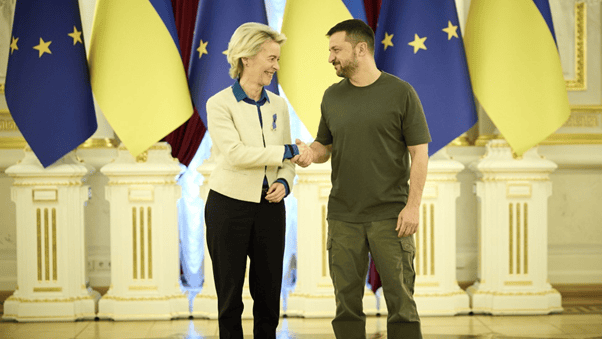
Photo. President of Ukraine
€135.7 billion—that is the estimated sum required to keep Ukraine financially afloat over the next two years. With the US stepping back from direct financial support, this burden will inevitably shift onto European shoulders. The timing is difficult: EU member states are already confronting growing fiscal pressure driven by rising defence budgets and other crisis-related expenditures. Yet, a relatively greater financial contribution also offers Europe a chance to play a more decisive role on the front line and in negotiations.
Against this backdrop, European Commission President Ursula von der Leyen sent a letter to European capitals on Monday, presenting three available options to finance Ukraine in an effort to reach an agreement before the end of the year.
The Commission’s preferred option is to mobilise the roughly €140 billion in frozen Russian assets held at the Belgian securities depository Euroclear. This would fully cover Ukraine’s projected financial needs for the next two years and spare EU member states from assuming further fiscal commitments. The idea is not new and has been the subject of significant debate and controversy since these Russian securities were immobilized in February 2022, due to potential repercussions for the stability of EU financial markets and the bloc’s global credibility, including the risk of capital outflows.
These concerns lie at the root of the EU’s self-imposed restraint on the issue. As the war continued and Ukraine’s fiscal situation deteriorated, pressure to use the assets gradually increased. Since spring 2024, the EU has been directing interest generated from the frozen Russian assets to support Ukraine’s defence, but this amounts to only €3 billion per year and remains a minor contribution. In October, EU countries appeared closer than ever to reaching a consensus, but the effort ultimately failed following Belgium’s refusal.
The Belgian government insists on solid guarantees from other EU countries, particularly regarding the sharing of financial and legal risks in the event of market turbulence or lawsuits filed by Russia under the 1989 bilateral investment treaty. The country seeks assurances that it would not be solely responsible for repaying the loan if complications arise. At the recent 14 November meeting, von der Leyen sought to reassure and win over Belgium PM Bart De Wever, but his approval remains pending—and will likely depend on the extent of risk-sharing commitments secured from other EU capitals.
An agreement to use the immobilised assets is likely, though not guaranteed. The momentum is clearly favourable, with the final decision appearing closer, while the circumstances—a determined Commission and financially pressured member states willing to commit—have never been better.
Nevertheless, in the end, the likely consensus may be that the Russian assets will be used only gradually, without fully meeting Ukraine’s needs. This would require resorting to the two remaining options, not to mention the scenario in which Belgium blocks their use altogether.
This is why the two remaining options outlined in von der Leyen’s letter—grants and shared debt—deserve closer attention.
In the case of grants, countries would agree to provide financial contributions, ideally proportional to the size of their economies, to secure the required amount. No new risks and no new mechanisms would be involved. However, this would mean immediate new expenditures, higher deficits, and consequently higher debt—precisely what many EU countries are currently trying to reduce. Moreover, some more fiscally constrained states, particularly those farther from Ukraine or less supportive of it, could opt out or limit their contributions.
In this light, the last proposed option appears less financially disruptive, as it would entail issuing shared borrowing on the markets for Ukraine, to be repaid by member states if reparations from Russia are not received. Joint EU-level debt has already been tested under the Next Generation EU programme after Covid-19 and through the SAFE instrument for European rearmament. This approach would allow the burden to be smoothed over the long term and would have a much smaller immediate impact on EU governments« budgets. However, many frugal countries may resist this idea.
Given the substantial financial costs of the other two options, EU governments may ultimately see the use of Russian assets as the least burdensome path. In October, member states pledged to „provide Ukraine with regular and predictable financial support in the long term,” including meeting „Ukraine’s pressing financial needs for 2026–2027,” with the first external financing required by the second quarter of 2026. For this reason, some decision must be taken in December; the question is whether it will be permanent or only temporary.
Regardless of what is agreed in December, the EU faces a more fundamental challenge: creating a durable financial architecture capable of sustaining Ukraine with tens of billions of euros each year. Another ad hoc grant package or a single round of joint borrowing will not suffice if the war endures. And even the frozen Russian assets, often portrayed as a panacea, are ultimately finite.
EU support for Ukraine in 2025 totals more than €20 billion, apart from much greater individual member contributions. In 2026, this sum will need to double or even triple, depending on the support from partners outside the EU. With Washington withdrawing direct financial assistance under Trump, the EU is effectively taking on near-total responsibility for sustaining Ukraine’s economy and war effort. Crucially, this shift alters the relative balance of influence over the course of conflict and future negotiations.
Becoming the principal enabler of Ukraine’s defence, Europe must claim a much stronger role in shaping the peace process and avoid being pushed to the margins, whether by Russia or the US. If the continent is expected to shoulder an even larger share of the financial burden, it must also wield corresponding influence over the conduct and resolution of the war.
